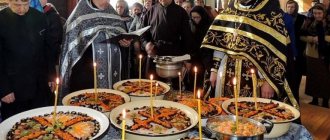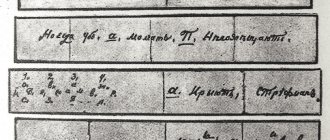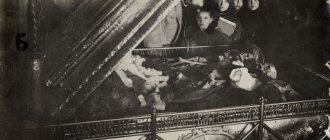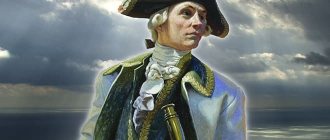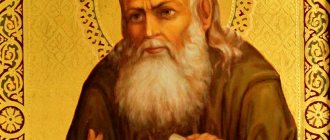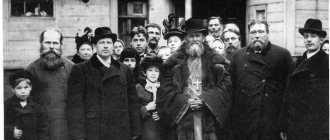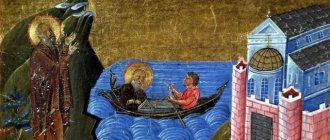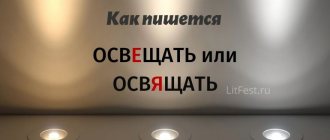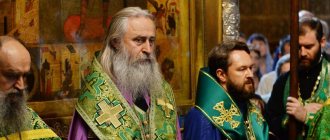"Save me, God!".
Thank you for visiting our website, before you start studying the information, please subscribe to our Orthodox community on Instagram, Lord, Save and Preserve † - https://www.instagram.com/spasi.gospodi/. The community has more than 60,000 subscribers. There are many of us like-minded people and we are growing quickly, we post prayers, sayings of saints, prayer requests, and timely post useful information about holidays and Orthodox events... Subscribe. Guardian Angel to you!
Many Christians immediately associate his name with healing, and there is a lot of evidence of this. Prayer to St. Theodore of Sanaksar can help even in the most difficult life situations.
Life of St. Theodore
In worldly life he is known as the nobleman Ivan Ignatievich Ushakov. He was born in the Yaroslavl province in 1718. Initially, his parents assigned him to military service in St. Petersburg, where the Preobrazhensky Guards Regiment was based. Perhaps he would have become a great commander-in-chief, but chance intervened in the life of Theodore of Sanaksar.
One day, while walking, his friend fell dead. It was this fact that showed him how unstable happiness is in this world. At the age of 20, he gives up everything and becomes a recluse. At first he stayed in the thicket of the forest on the banks of the Dvina, and then in the cell of the Ploshchanskaya hermitage. Due to lack of documents, he was captured and transported to St. Petersburg.
These six years have significantly changed his appearance. The humility in him was a special wonder for everyone. The Empress forgave him for his escape and returned all his previous ranks, but he asked permission to become a monk. After some time, this event happened in the Alexander Nevsky Lavra. He always had a desire to go to the Sarov monastery. In 1757, with some of his followers, he went there.
The best article for you, go to: Holy Apostles Peter and Paul: icon, prayer, day of celebration
The girls were settled in the St. Nicholas Monastery, and the men settled in the Sarov desert. After spending two years there, he went to the Sanaksar monastery with the goal of restoring it. Philanthropists helped him in this. In 1762 he was ordained a hieromonk. Everyone noted his severity and firmness.
Days of Honor
In 1774, due to denunciation, he was exiled to the Solovetsky Monastery. Only after 9 years he was able to return back. He died in 1791. Remembrance days fall on:
- March 4;
- May 4th;
- June 5.
Sanaksar monastery
At that time, the Sanaksar monastery was poor and half empty. Theodore energetically took up the improvement of the monastery. In 1762, Bishop Pachomius (Simansky) of Tambov, knowing Fr. Theodore, called him to himself, convincing him to accept the priesthood and become abbot. Out of his humility, the elder refused for a long time, but was nevertheless convinced by the bishop and ordained a hieromonk with the instruction to bear the duties of the rector of the Sanaksar hermitage.
According to the charter laid down by Theodore, services in the monastery were held for 10-12 hours. Each brother was obliged to immediately confess any thought to his confessor. All the monks were present at the common meal, with the exception of the seriously ill. The food was simple and moderate, without pies and white bread, which was not supposed to be eaten even on Easter. The cells were not supposed to have any constipation. Each brother was given one or two books from the library for edification. Everyone was required to attend the general monastic labors - mowing, fishing -. The abbot himself went to work with the brethren.
What does Theodore of Sanaksarsky help with?
It will not be a secret to anyone that at certain periods of our lives we all turn to the saints for help. Remember that our faith plays a big role in this process. The stronger it is, the greater the likelihood of obtaining a positive result. Your thoughts must be pure and your heart sincere.
The most common petitions to his holy face:
- about healing from mental and physical illnesses;
- about making the right decision;
- about resolving a difficult life situation;
- about strengthening faith;
- about giving a miracle;
- about material well-being;
- about forgiveness of sins and so on.
The best article for you, go to: Holy Archangel Michael: holiday, what it helps with, how to pray
Return to home
Finally, at the request of Metropolitan Gabriel of St. Petersburg and the Highest command of Catherine II, Fr. Theodore received complete freedom and returned to his native Sanaksar monastery. With great joy, the monks and nuns met their beloved spiritual father, crying with joy, kissing his hands and bowing to the ground at his feet. Having taught the pastoral blessing, he thanked everyone for their memory and love.
Having settled in his beloved monastery, the elder continued to work diligently for the Lord.
Prayer at the icon of St. Theodore
Quite often, believers buy images of saints for their home iconostasis. Finding a wall icon of Theodore of Sanaksar in a church is not easy. There is a mention that it is located in the Church of the Intercession of the Blessed Virgin Mary in the city of Khabarovsk. But as homemade options, they are sold in candle shops.
Pronouncing your cherished words in front of her will help you focus on what is happening and not be distracted by other things. If there is a desire to bow to the relics, then this can be done at the place of his final resting place. The most commonly used is prayer. This is what she looks like.
“Oh, our joy! To our shepherd, Rev. Father Theodore! We sigh from the depths of our hearts and cry out to you with tears: you see our weakness, our abiding in the darkness of passions, weakening of spiritual strength, self-will, captivity through carnality, and impoverishment of all virtues! See our crying and bewilderment! Enlighten us and instruct us on the path of salvation, ask us from the great-gifted God of our poverty for knowledge, tearful repentance, unfeigned humility and unceasing patience in prayer, so that by this His goodness we may incline ourselves to the forgiveness of sins and be worthy to abide with you forever in the Kingdom of Heaven, singing and blessing the All-Holy Trinity: the Father, and the Son, and the Holy Spirit, now and ever, and unto ages of ages. Amen."
At services you can often hear the troparion to Theodore of Sanaksar.
“Being like the Baptist with zeal, / having pleased God from youth, / the gracious old disciple appeared to the multitude, / and with them you rejoice in Heaven. / Our Father Theodora, / pray to Christ God // for the salvation of our souls.”
The memory of him is most revered in his homeland and in the monastery that he rebuilt. There are also some structures that are named after him. For example, the Church of Theodore of Sanaksar in the city of Saransk. It was placed on the territory of an abandoned brick building of a bath and laundry plant. The temple was handed over to the community in 2001, and then its reconstruction began. Reconstruction work is carried out periodically. Those who wish to visit it can find all the information on the official website.
The best article for you, go to: What does the Icon of Unexpected Joy help with?
God bless you!
You will also be interested in watching the video story about St. Theodore:
Clergy
For spiritual and moral enlightenment, Theodore constantly spoke general teachings to the brethren - in the temple, at meals and in cells, teaching them to cut off their own will, listen to the advice of the elders and struggle along the narrow, sorrowful path. Didn't leave Fr. Theodore was without instructions and the laity turned to him for consolation and admonition. He advised the rich not to cling to wealth, giving it to the poor; he urged the poor to work hard and honestly fulfill their duties.
The life of the abbot itself was instructive - the elder was distinguished by humility, meekness, kindness, straightforwardness and the same kindness towards everyone.
News feed
Holy righteous warrior Theodore Ushakov
From the book “Admiral Ushakov”. To the 5th anniversary of the act of church glorification of the righteous warrior Feodor Ushakov, the invincible Admiral of the Russian Fleet
MIRACLES IN THE SANAXAR MONASTERY The glorification of the holy righteous Fyodor Ushakov took place solemnly, brightly, joyfully. Together with Metropolitan Kirill, Bishop Seraphim of the Baltic from Kaliningrad, and other priests, my wife Svetlana and I flew by plane from Moscow to the still “closed” city of Sarov. A quick meeting without checking documents, and a cavalcade of cars leaves for Sanaksary. Yes, this triangle - Sarov, Diveevo, Sanaksary - is marked by God's favor. Arzamas physicists told me about calculations and observations that confirmed that a kind of fracture of the earth’s layers is taking place here, infrared and other rays are focused in a special way, so here is a special, fertile, spiritually uplifting place. That’s why Seraphim Sarovsky was here, Fyodor Ushakov was here, that’s why Arzamas-17 was here, where the Soviet atomic bomb was created, which kept the planet at peace for fifty years, in a state of balance...
I don’t know what about the physical fields, but the spiritual highest cover definitely extends over these lands. I remember when we arrived in Sarov in 1997 to establish a branch of the World Russian Council, we, of course, immediately went to the spring of Seraphim to wash ourselves. We stood for a long time at the stone on which he spent many days and nights, praying for us, for Russia. And then we were in Diveevo, at the shrine opened for the leaders of the Cathedral, and, quiet, peaceful, walked around the convent decorated with flowers. Yes, here is holy land, here the spirit of the righteous and uplifting Seraphim of Sarov soars, here is a special grace and a special state of prayer. And it is no coincidence that monk Fyodor, uncle of the future admiral Fyodor Ushakov, came here from St. Petersburg with his spiritual children. And it is not by chance that he was commanded to expand the Sarov field to the Sanaksar monastery.
Here comes Sanaksary. I don't recognize the monastery. It is light, beautiful, painted, bleached, repaired. Just a fairytale palace. This is probably how my mother-in-law Anastasia Alekseevna saw it when she came to it from the nearby village of Selishche. She left there as a child, but remembered this fabulous monastery all her life.
We dined with the governor Barnabas in his reception chambers, on the second floor, together with the entire priesthood. Bishops arrived from Penza, Ulyanovsk, Tambov, Kaliningrad, and other places. There were an unusually large number of guests, the monk did not have time to carry them around. The busy Barsanuphius, Archbishop of Mordovia, could not stand it and jumped up, helping to carry the plates so that the meal went faster. This amazed me and reproached me in a good way. Everyone was waiting for the evening service to begin. The meal is over. We prayed. Svetlana went to the monastery. Everyone was concentrated, waiting for Metropolitan Kirill’s signal. And journalists approached him from all sides. From the porch of the guest house he gave interviews and answered questions. They ask me questions too. “What miracles were there around the admiral?” — the lively journalist insisted. Bishop Kirill answers, I answer: “Isn’t it a miracle that a saint appears to help our fleet in prayer? Isn't it a miracle that he conducted forty campaigns and did not suffer a single defeat? Isn’t it a miracle that he rested in the same grave with his uncle, the future Saint Feodor? Isn’t it a miracle that he came to us, to our people, from oblivion, during the difficult times of the Great Patriotic War? And even now, after the glorification, miracles will surely happen.”
In a large, beautiful monastery courtyard divided by rows of birch trees, a tabernacle was built, and services were held there. A column of banner bearers from Moscow slowly enters. Before this, one of the priests cautiously asked me: are these not Barkashov’s people? Everything that is organized and united by the Russian people arouses suspicion, fear and even horror among our democratic media. And they spread this fear to others. I answered him that there are many worthy people there, I was with them at a rally in Ostankino against the NATO bombing of Yugoslavia.
Banner bearers decorated the service, flanking a long golden row of clergy stretched out in front of the altar. Behind them stood chains of military and police officers protecting the service. Behind them are pilgrims who filled the entire monastery courtyard. Prayers soared into the sky. The all-night vigil began. The priestly and monastic choir sang harmoniously. The service has begun. And then - a religious procession to a small church with a coffin, where the private remains of Fyodor Ushakov were located. Banners were carried in front, followed by Metropolitan Kirill, other hierarchs and admirals, and admirals. The Mordovian land has never seen so many admirals. From now on, Mordovia can be considered a maritime power. The sky is gray, gloomy, gusts of wind carry dark clouds. It wouldn't rain. We approached the church. I stopped with Svetlana at the very entrance; we couldn’t go in there anymore. The Metropolitan and the priesthood are celebrating a litiya, and a blue haze of incense flows from the church. The litia is completed, the admirals take the coffin with private remains on their shoulders and leave the temple, taking the first step. And then one of the miracles happens before our eyes: the gloomy sky suddenly parted and a straight, dense column of light fell on the exit from the church. The procession is highlighted, the clouds part over Fyodor Ushakov. Thousands of people gasp and pray. What a miracle! The hesitant orchestra thundered “Roll the thunder of victory!” A joyful and bright wave of people goes to the bust of the admiral in front of the monastery. Commanders, sailors under the banners of the fleets.
The head of the Republic of Mordovia speaks, the chief of staff of the Navy speaks. The civil part ends. Metropolitan Kirill delivers the word. Firework. The archbishops approach the coffin and take the remains of Fyodor Ushakov on their shoulders. From now on it is under the shadow of the Orthodox Church.
But here's another wonderful detail. The reliquary must be covered with a shroud. The monk carrying her hesitated. And then the commander of the Black Sea Fleet quickly tore the fleet flag from the staff and covered the reliquary. In the evening at the reception, he asked not to scold the monk: “After all, he, Fyodor Fedorovich, had to sail to a holy life under the St. Andrew’s flag of his Black Sea Fleet.”
And the solemn glorification began in the monastery. The text of the deeds of the new saint of the Russian Orthodox Church was read out to the ringing of bells. It's finished! Prayers were offered, psalms and songs were sung in honor of the new saint of the Russian Orthodox Church. Vladyka Kirill was the first to approach the relics and venerate, followed by bishops, monks, and admirals. I stood with the icon of Fyodor Ushakov to the right of the altar and prayed, sometimes blinking away tears. He approached the relics and venerated them. Holy Righteous Feodor, Admiral of the Russian Fleet, from now on you will be in the souls of the Orthodox Russian people, our soldiers, our sailors are waiting for your intercession!
And again miracles happened overhead: a cross formed in the clouds above the monastery courtyard. Vadim Arefiev rushed to take photographs, although the clouds had already moved. In our memory, the cross has become another symbol of this great day of our fleet.
In the evening there was a meal. After the words of Bishop Kirill, the admirals were, of course, a little confused. Their admiral, a naval navigation genius, a hero was glorified, but why a saint?
They did not all know about the righteousness of Fyodor Ushakov; not all of them associated his selflessness in service and persistence in serving people and the Fatherland with holiness. They did not know well enough about the last period of his life at the monastery and in the monastery, about his charity and mercy. But they all felt that a great event was taking place. Metropolitan Kirill also spoke about this: the first sailor-saint among Christians, the first man in uniform, who came from secular military service to the monastery and stood in line with many saints and righteous people of Rus'. At the press conference, he also noted that Valery Nikolaevich Ganichev also made efforts for this glorification. It was pleasant, but I knew that everything was happening according to the will of God, through the prayer of all the monastic brethren. His Holiness the Patriarch, Vladyka Kirill himself, Archbishop Barsanuphius of Mordvia, Metropolitan Yuvenaly, the abbot and brethren of the Sanaksar Monastery, especially Hieromonk Benedict, and many others have been tirelessly, painstakingly working on this since 1995. I thought about this earlier, studying documents and materials about F.F. Ushakov in the Central Archive, the Navy Archive, in Leninka and the Saltykov-Shchedrin Library in Leningrad, in the archives of Nikolaev, Saransk, Rybinsk, Sevastopol, Kherson, Kerkyra. However, he expressed his opinion that the admiral’s life was righteous and holy in Saransk on the anniversary of the admiral’s 250th anniversary in 1995. Bishop Barsanuphius was supportive, but some monks from the Sanaksar monastery were skeptical: he was not a church person, not a martyr. I convinced, cited facts. And then I decided to write a letter to His Holiness the Patriarch. He supported it, and at one of the receptions he said that this would be important for our fleet. The Mordovian diocese also sent its petition.
The Synodal Commission for the Canonization of Saints of the Russian Orthodox Church, headed by Metropolitan Juvenaly of Kolomna and Krutitsky, considered the submissions for a long time. I studied documents, evidence of miracles. Every time we met, Bishop Yuvenaly kindly told us how the work was going. And at the Christmas reception in the Patriarchate in 2001, he opened his arms and said in his low, pleasant voice: “Congratulations to you, the canonical commission has considered everything and canonized Fyodor Ushakov as a locally revered saint,” and then, turning to those accompanying him, he added approvingly: “Here are the secular people help us." Then he hugged me, repeating: “Congratulations, congratulations.”
Yes, in August 2001 we all should have been congratulated. And already on August 5, as if the solemn liturgy was heard throughout the whole country and the troparion sounded: “The invincible Russian archangel appeared, treating the Hagaryan malice as nothing and destroying him: neither the glory of the world, seeking less than wealth, you served God and your neighbor. Pray, Saint Theodora, to truly grant us victory over our enemies. Let the Fatherland remain unshakable in piety and let the Russian sons be saved.”
The liturgy was beautiful, colorful, sublime and joyful. The sun was shining, the row of birch trees in the light breeze inclined their tops towards the tabernacle. People kept coming. The owners did a great job. Tents were set up in the forest. There and in the former pioneer camp, several thousand pilgrims, pilgrims and just tourists spent the night in cars (they say ten to fifteen thousand). We also settled in the camp, settled down in a cool, even chilly house above the beautiful Moksha.
The liturgy is over. The choir sings glory. It's all done. But people don’t leave, they go to church and buy icons with the face of Fyodor Ushakov. I'm going to my last meal. There are hierarchs, admirals, and leaders of Mordovia. Everyone is in high spirits. I also said a few toasts and presented President Merkushkin with the book “Admiral Ushakov.” Admiral Chernavin, former commander-in-chief of the Navy, my fellow countryman from Nikolaev, shook my hand. The cars drove off one after another. And I also went with Svetlana, Marina, Nastya to the cell of an old friend, Hieromonk Jonah. They prayed and remembered how they began to prepare for the glorification, how he doubted his success. “But how wonderful it all happened! Well, let’s go, let’s venerate Saint Theodore once again.” They venerated the relics. Svetlana asked: “Did you bow to the relics of the elder?” Yes, I have already bowed before. But he went, knelt in front of the shrine, and prayed to Fyodor Ushakov’s uncle. Of course, it was this holy righteous Feodor who influenced his nephew and led him on the path of holiness. His stern, direct gaze from the icon spoke of spiritual exactingness (his righteous life was wonderfully described by the famous Orthodox writer Poselyanin) and in the book “Instructions to Spiritual Children” by St. Feodor of Sanaksar, compiled by Hieromonk Benedict.
There is almost no one in the temple, only nearby, to the left of the altar, a shrine is being prepared for the righteous Russian admiral. I approached the amazingly carved lid of the reliquary in the form of a sea frigate with scenes from the holy life of Righteous Fyodor, stopped, admiring this work of art, and asked the person laying something on the reliquary if he was the artist who created such beauty. “By the providence of God,” he corrected my question. Suddenly church singing was heard at the entrance, and a procession entered the temple. My God! The relics of the holy righteous Feodor are brought in. What happiness! What a sign! I meet the relics of Fedor at his future eternal place. The service is being performed. The relics are placed in place during prayer. I pray and apply myself, apply myself. Jonah comes in with many believers and quietly whispers: “Well, of course, of course, who should have been there!! Who else?" Thank you, Jonah.
We drove back on the Volga through Mordovia, the Ryazan region. On the outskirts of the famous historical town of Shatsk we stopped at a small restaurant, because near it the St. Andrew’s banner was flying on a high mast. At the foot of the mast lay a ragged anchor. The director of the restaurant, having learned that we were from Ushakov, greeted us cordially and set the table himself. “I have a friend who is a prosecutor, he loves the sea, he even made sea trousers, with buttons on the side. So he inspired me.” And a round dance of the guests present—the region’s road workers—spun around us. “Are you from Ushakov? As there? Were there miracles?
As we approached Moscow, the sun turned purple and set in a niche clearly formed from the clouds, scattering its rays along the ridges. Yes, for me it was one of the most sublime and beautiful days of my life, the most spiritual, framed by miracles and the manifestation of God’s will.
And the miracles continued. At the meal, the commander of the Russian Black Sea Fleet (there was also the commander of the Ukrainian Black Sea Fleet) asked to transfer a particle of the relics to their fleet, others also spoke about this. Metropolitan Kirill announced the next morning that the decision had been made and particles of the relics of the holy righteous Fyodor Ushakov would be transferred to the churches of these fleets.
By the highest will, I managed to attend this holiday in Kaliningrad and Baltiysk that same year. On the evening of November 24, particles of the relics and the icon of Fyodor Ushakov were exhibited in the wooden Kaliningrad Cathedral of Christ the Savior. After the service and reading of the troparion, parishioners venerated the relics. The Bishop invited me and Governor Yegorov (former commander of the Baltic Fleet) to the altar. During the break, we talked with the governor about the fate of the Kaliningrad region. “Many people have never been to Russia,” he lamented. — Young people travel to Germany and Poland, but have never been to Russia. Hard".
Well, the next day the convoy of cars moved to the city of Baltiysk - the base of the Baltic Fleet. A car with an icon and particles of relics was driving ahead. It was gloomy, windy and foggy. We passed border control (Baltiysk is a closed city). We go out to the embankment, to the monument to Peter I standing over the sea. The fleet commander says a short word about Ushakov. Then the prayer of Metropolitan Kirill. The Bishop raises up the icon of the holy admiral, and - oh, miracle! The clouds began to disperse, and twenty minutes later a clean, clear, blue sky shone over Baltiysk. Bishop Barsanuphius turned to me and joyfully exclaimed: “Well, as it was then!” Yes, as then, in Sanaksar, the sun miraculously illuminated the coming of Ushakov’s relics to the Baltic Fleet. The miracle continued further. The clouds dispersed to the very horizon. On the first boat, the commander, the metropolitan, priests and several journalists moved along the line of ships. Somehow I managed to join them.
The boat initially walked along the right line of warships, on the deck of which the crews were lined up. The Metropolitan raised the reliquary icon and blessed the sailors on the ships with it. One, second, third, fifth ship... Then the boat turned around and moved along the left lane. “Hurrah!” thunders from the decks. Orchestras are playing. The gentle sun (as if on a spring day) illuminates the ships stretched along the embankment of the residents of Baltiysk, our joyful boat, priests and sailors. "Miracle! - the officer-journalist tells me. “After all, a chilly winter has already set in, and here is the sun again!” We are approaching the last military patrol. “Hurrah!” rang out. And suddenly a flock of swans swims out from behind the bow of the ship. White, luminous, unreal, but real. I turn to the commander: “What is this? Can swans live here? He hesitantly says: “Yes, they are here, by the sea...”
The reliquary and the icon were taken out of the boat and installed on a raised platform. The entire black-jacket formation marched in ceremonial steps, aligned with the shrine. Then they were taken into the Church of St. George and left there forever.
From now on, the spirit of the holy righteous Fyodor Ushakov will hover over the Russian Kaliningrad land. Almost forty temples and shrines of Ushakov make the land eternally Russian.
After the ceremony, they gathered in the large hall, where the mayor of Baltiysk addressed the city and the fleet. The Metropolitan and the fleet commander spoke. They gave me the floor too. He spoke about Ushakov’s ministry. The commander excitedly addressed the audience: “Comrades, members of the Military Council of the Fleet, I propose to introduce Metropolitan Kirill and the writer Ganichev into members of the Military Council of the Baltic Fleet for the cause of consecrating and glorifying Fyodor Ushakov! Who agrees"?" The audience applauded unanimously. All! From now on, warships are at the disposal of the Russian spirit.
We were returning from Baltiysk in drizzling rain. Clouds covered the sky again. But my soul was joyful and light.
FEDOR USHAKOV CAME TO CORFU AGAIN. What should have happened a long time ago has happened. 2002 On the island of Corfu (Kerkyra) a memorial to Admiral Ushakov was erected...
An extraordinary procession moved along the narrow streets of Kerkyra. The island's orchestra, dressed in Greek clothes, was ahead, followed by the brave sailors-orchestras from the landing ship "Yamal", then - a clear column of our military sailors with the flags of Russia and Greece and the St. Andrew's banner. In the center of the procession, Father Dimitri and Father Vladimir carried a large consecrated icon of the Holy Righteous Fyodor Ushakov, admiral of the Russian fleet.
The orchestra played inspired marches. When they entered Nikifor Betokia Street, the priests sang “Most Holy Theotokos, save us...”. And then “Holy Righteous Theodore, pray to God for us...”, “Holy Righteous Spyridone, pray to God for us.” There, to the Church of St. Spyridon, the procession went. There, because in 1799, when Admiral Ushakov stormed the fortress, on Easter Day he also went through a religious procession and personally with his comrades carried the relics of St. Spyridon to the same temple.
And just like probably two hundred years ago, all the residents poured out onto the streets of the city. The faces were familiar, spiritual, and friendly. People looked with interest at the clear formation of Russian sailors and were transformed when they saw the large icon of the holy admiral. Here is a gray-haired, hunched old man fervently crossing himself, strong-looking men are bowing down, young Greek beauties were just smiling carefree at the sailors and suddenly, becoming more serious, they cross themselves on the face of the saint, children in flocks stop, run forward and kiss the icon.
...Fyodor Ushakov again walked through his city, which he liberated from the boorish soldiers of the French Directory, through the city in which he cleared the churches of the rubbish of godless revolutionaries, through the city in which he created and bestowed on the population the most democratic constitution at that time, stopping quarrels and clashes of classes. Yes, it was he, Admiral Ushakov, who proclaimed here, on the seven largest islands, the first Greek independent state after 300 years of Ottoman yoke: “Therefore, we Greeks must consider Fyodor Ushakov the father of our independence!” - said former member of parliament, former minister, right-wing conservative Gerasimos Apostolos. And Mayor Christo Sarles organized a holiday in memory of Ushakov. The whole city was plastered with posters about this and the holiday program.
The holiday began at the walls of the old fortress, where the long-awaited memorial to Fyodor Ushakov was opened.
The mayor of the city, our ambassador, the creator of the monument, the son of Russia and Greece, sculptor Viktor Aidinov said their word. Archbishop of Saransk and Mordovian Barsanuphius performed a prayer and consecrated it.
The triple salute of sailors from the landing ship "Yamal" raised birds from the bastions of the fortress, aroused delight among the boys and marked the fact that the monument to Admiral Ushakov now stands not only in Moscow, St. Petersburg, Sevastopol, Rybinsk, Sanaksary, but also here, on Kerkyra. Wreaths from the city and the Embassy of the Russian Federation, from the Black Sea Fleet, flowers from naval cadets from Moscow fell at the foot. I placed my latest book, “Admiral Ushakov. Naval Commander and Saint." I worked for almost thirty years, comprehending the spirit of the great admiral. At first I wrote about him as a naval commander, hence the book “Fleet Leader”, wrote about him as a sovereign statesman (the book “Ross the Invincible”), reviewed his whole life in a historical and artistic biography (a book in the ZhZL “Ushakov” series).
And according to the Higher Will, I felt that the admiral lived his life as a holy, righteous man, at the end of it he distributed his wealth, lands, money to people, churches and spent his last years near and in the Sanaksar monastery itself in the Tambov region (now Mordovia).
Yes, 43 military campaigns - and not a single defeat, not a single captured sailor, participation in the construction of Sevastopol, the Black Sea Fleet, the creation of the first independent Orthodox Greek state, the righteous life of a prayer book and a merciful person - all this made his appearance holy for us.
The Synodal Commission for the Canonization of Saints of the Russian Orthodox Church, headed by Metropolitan Yuvenaly, decided to canonize Fyodor Ushakov, admiral of the Russian fleet, as a locally revered saint. This was greeted by Orthodox people with joy. 15 thousand pilgrims, almost 40 admirals, naval commanders gathered on August 4 and 5, 2001 at the glorification of the Holy Righteous Fyodor Ushakov in the Sanaksar monastery of the Mordovian diocese.
Archbishop Barsanuphius spoke about all this at a press conference in Corfu. When asked by one of the correspondents what brought together the military, writers, priests, and entrepreneurs sitting in the hall at this Ushakov holiday, he replied: “We are all united by his holiness.” I think he is deeply right. This is the quality that united not only us, but also Orthodox Greeks around Ushakov. And probably, almost all the Greeks standing on the streets of Kerkyra were Orthodox. Perhaps, after the church glorification in the Sanaksar monastery, the presentation of a particle of the relics of the holy admiral to the entire Baltic Fleet in Baltiysk, the religious procession and the opening of the monument were the most striking event in my entire “Ushakoviada”...
...The procession column turned into the street the national hero of Greece, a famous Greek figure, one of the founders of the independent Greek state - Kapodistrias, a man whose talent served Russia for a long time. In Russia, he headed the Ministry of Foreign Affairs. The great friend of Russia, Kapodistrias, according to some sources, was killed by English opponents of the Russian Empire. The British did their best to eradicate the age-old mutual affection of Russians and Greeks. When in 1987 I worked in the archives of Kerkyra, the folders with documents about Ushakov’s campaign were labeled “Russian-Turkish occupation.” In response to my indignant exclamations about this classification, the archivist shrugged his shoulders embarrassedly and said: “There is a lot here from English chronology.” Yes, for the British, who captured the islands after the defeat of Napoleon and established themselves there as masters, their mission was designated as important and creative, and the liberation of the islands by Ushakov and the creation of the first Greek state there in modern times was an occupation. This view was fixed in the minds of many Greeks. A professor of modern history from Athens, after my speech, after the words of Gerasimos Apostolos about Ushakov’s mission, said with contrition that he knew absolutely nothing about the role of Ushakov in the history of the Greek state. The professor didn’t know, and, unfortunately, neither did some of our former diplomats.
Since 1987, I have written to several ambassadors that there should be at least two Russian monuments in Greece - to Fyodor Ushakov, the creator of the first modern Greek state, and to Alexander Pushkin, as well as Byron, who sympathized with the struggle of the Greek people for independence. Byron fought and died for Greece. During his southern exile, Pushkin knew many future rebels and was even in love with a beautiful Greek woman. And now there is a monument to Ushakov. To be in Greece and the monument to Pushkin!
The expedition members were able to travel through the memorable places of the island. Today they are acquiring real spiritualizing features for our compatriots. The features and contours of the great Ushakov appear everywhere.
Opposite the fortress, opposite the new monument to the admiral, lies the island of Vido of incredible Mediterranean beauty, but in 1798-1799 it was a bastion bristling with cannons that did not allow the admiral’s ships into the strait. On another island there is a small monastery, differing from ours in its miniature size and natural comfort. Near the restaurant platform, from which the monastery and the strip of the airfield are overlooked, a miraculous evidence is suddenly discovered - a cannon, peacefully observing order in the bay. Yes! Yes! This is the weapon that protected the small Russian garrison and Greek rebels on the approaches to Kerkyra. I stroke the gun, clearly distinguish a double-headed eagle, feel the current of the last year of the 18th century through it, see how Russian gunners hammer a charge, a cannonball, and hear a shot, meaning the liberation of the island.
On the last day I was especially lucky. In the morning they gave us a car and we rushed to the east coast to the village of Ageokostritsa. When I was working on a novel and a book for the ZhZL series, I described from documents how the residents asked Ushakov for help to protect the village from the French garrison, how he allocated them a gun and six gunners, how the residents built a bastion and how, without waiting for the deadline, they began to shoot at to the French, and they organized an attack, captured prisoners and shot them. In a truly biblical place, surrounded by flowers and blooming trees (this is at the end of October), there is a monastery, just as it stood under Ushakov. The miraculous icon of the Mother of God, which the Greeks told us about, is in a silver frame with chains and crosses strung around it. And next to some kind of pulsating light is an icon in a wooden frame, donated to the temple by Russian officers of Ushakov’s squadron. We pray in front of her, and draw together a spiritual thread with the liberators of the islands. At the entrance, with its mouth turned towards the turquoise Adriatic, there is another weapon. This is what protected the residents of Ageokostritsa and was shrouded in gunpowder smoke in the winter days of 1799. We go down, bow to the temple of St. Pantileimon - and forward to Kerkyra, to the airfield. On the way, we share our impressions of yesterday's Russian gala concert in the fortress. It was impressive in scope and modernity. True, some Greeks, and they are mainly adherents of national and classical music, asked: “Are there any world-class pianists, violinists, cellists in Russia now?” I had to answer briefly that there were some, but they were probably busy right now and couldn’t go (I probably couldn’t vouch for the reliability of this data). However, the dancers of the MVO ensemble, Ekaterina Shavrina, Rastorguev’s “Lyube”, as well as the well-known Gazmanov were loved by the audience. Oleg Gazmanov admitted that he really loves historical novels, and I gave him Ushakov. Then I learned from a drummer from his orchestra that Oleg had been reading on the beach all day. He turned out to be an attentive reader and at the concert he voiced some facts from the book. It is still useful for artists and writers to travel together.
For three days Kerkyra was in the power of Ushakov. The opening of the monument, the religious procession, the transfer of the blessed icon to the Church of St. Spyridon, the Greeks’ visit to the Yamal landing ship, the presentation of Academician Tarle’s book translated into Greek, a meeting of Russian and Greek entrepreneurs and a grand gala concert in the New Fortress, ending with an impressive fireworks display. And all under the sign of the great admiral and invincible warrior, defender of the Russian land and the Orthodox faith, as the prayer says. Yes, it was a great holiday of Russian-Greek friendship, the holiday of the Holy Righteous Fyodor Ushakov.
The holiday turned out to be a sovereign, imperious, state holiday for us, because Duma deputy S.Yu. was present at it. Glazyev, head of the Department of the Ministry of Foreign Affairs, our ambassador, all our attaches - military, naval. It was a naval holiday, because our military and naval ship Yamal arrived there, the last Soviet commander of the Black Sea Fleet, Admiral Khronopulo, and the current deputy commander of the Black Sea Fleet, Rear Admiral A. Kovshar, were there, and there was a brilliant team of Russian naval officers on the islands. It was a celebration of Russian-Greek friendship with the participation of broad sections of the Greek population, the mayor, heads of travel companies, and scientists.
During the reception on the Yamal, as in the 18th century under Ushakov, merchants, sailors, city employees, and diplomats climbed aboard the ladder. The breeze was fresh, and the Russian drink, which in Ushakov’s reports was designated as “white wine,” warmed the talkative and cheerful guests.
Well, and of course this holiday was spiritually Orthodox, blessed by our Patriarchate, with the participation of the Greek priesthood. Under the gracious sign of the most revered saint on the island, Saint Spyridon of Trimifuntsky and included in the all-Russian and pan-Orthodox spiritual power of the holy righteous Fyodor Ushakov. The coordinator and organizer, the soul and heart of this holiday, was the Russian Entrepreneur magazine, and other organizations also helped. I can imagine how much effort and nerves had to be spent, how much money and hearts had to be invested to make all this happen. I think that our history should bow to them for the fact that they cherish the memory, strengthen the spiritual thread coming from the depths of centuries.
Prayers
The Creator Angel sent you, Reverend Father Theodora, to the Russian land for glory and protection, to the faithful of the house of the Most Holy Theotokos for prayerful care, to those who thirst for salvation in Christ Jesus for wise spiritual nourishment, to the prayer books of the Russian land for grace-filled teaching. We, marveling at the providence of the Almighty for you, repentantly call to you: Rejoice, the most blessed adornment of the earth, Rejoice, the image of meekness and humility. Rejoice, prayerful care for us before God, Rejoice, shield and fence for the faithful in spiritual warfare. Rejoice, persecuted Christ for our good teaching, Rejoice, our reverend father Seraphim of Sarov of all Russia, the wonderworker of all Russia, sent by God for a century as an image of good pleasure. Rejoice, courageously placing the yoke of God on yourself, Rejoice, warm prayer book, unshakable shepherd in the truth of God. Rejoice, reverend Father Theodore , the joy of Christ in holy Rus' for the salvation of all the faithful.
